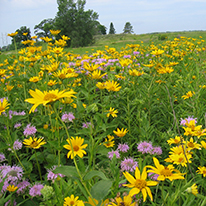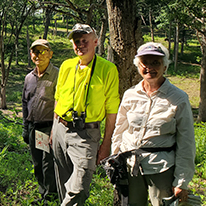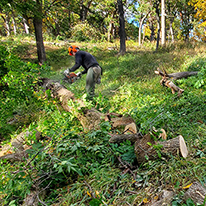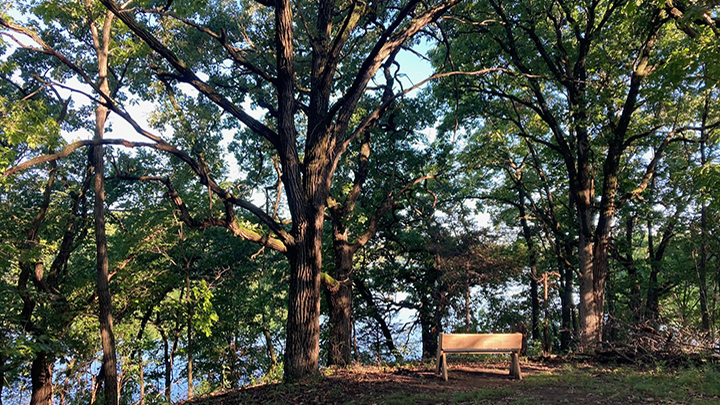
Scenic Overlook #2 at Silverwood Park in summer 2020
If you’ve hiked the trails through Silverwood Park’s wooded areas, you might have noticed the open nature of the understory in the south end. That’s because this area is slated for restoration to oak savanna. Once restoration is complete, this part of the park will will be more like what the first settlers might have seen when their wagons rolled across the tallgrass prairie.
Lars Higdon is the Botanist and Arborist/Naturalist for Dane County Parks. He has worked with the Friends of Silverwood Park to create a vegetation master plan. “My role is to work on natural areas stewardship,” Lars said. “The volunteers are our biggest and best resource for getting the job done.”
The vegetation master plan calls for three primary natural communities: Oak Savanna/Opening, Oak Woodland, and Southern Dry-Mesic Forest. Lars explained, “The terms refer to the structure of the site, meaning the physical arrangement of the trees and their density, but also the species composition that you find there. A prairie would be almost 100% open, maybe a tree here and there. An oak savanna is a little bit more wooded, but not much, maybe 10% canopy up to possibly 50% at the high end. Moving up–anything with 50% to about 90% canopy cover, we think of as woodland. Greater than 90% would be forest.”
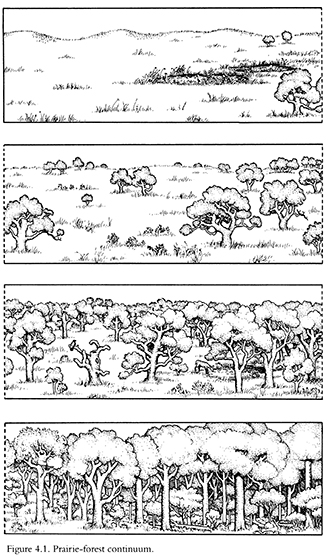
Prairie-forest continuum. From The Tallgrass Restoration Handbook edited by Stephen Packard and Cornelia F. Mutel. Reproduced by permission of Island Press, Washington, D.C.
The oak savanna, or opening–either term is correct–will occupy most of the south end along the shore of Rice Lake. Further from the shoreline, restored oak woodland is the goal. Here you won’t see much change other than the removal of undesirable tree species to protect the health of the oaks. The “L” at the north end of the wooded area will be maintained as Southern Dry-Mesic Forest. This type of forest occurs on the loamy soils of glacial till plains and moraines like Silverwood Park’s. Trees common in dry-mesic forest include red and white oak, American basswood, sugar and red maples, white ash, shagbark hickory, and wild black cherry. We won’t be allowing many maples in this area. The understory flora is typically diverse and includes spring ephemerals and wildflowers such as jack-in-the-pulpit and may apples.
Work is now underway to remove invasive shrubs and trees that are not compatible with the plan. But you won’t ever find Silverwood Park groomed like a golf course! More seeding with prairie plants will take place and fallen limbs will be left in place, to create high-quality wildlife habitat. Hikers should stay on designated trails, to limit disturbance to the furred and feathered residents we are trying to help.
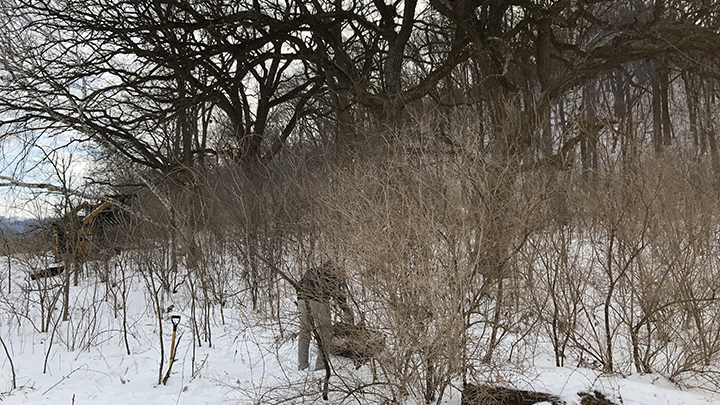
Buckthorn is an invasive species being removed from the woods
What’s an Oak Savanna/Opening?
An oak savanna or oak opening is an ecosystem featuring open-grown oaks—those with broad spreading, horizontal branches—scattered across grassland. The open canopy that these spread-out trees create allows sunlight to reach the ground, which gives oak seedlings and prairie plants the light they need to grow among the trees.
Common wildflowers in oak savannas include tall anemone, shooting star, woodland boneset, late horse gentian, leadplant, and little bluestem. A restored Oak Savanna at Silverwood Park will supply needed habitat for those and also for more rare plants, such as pale purple coneflower, rough rattlesnake root, and yellow giant hyssop.
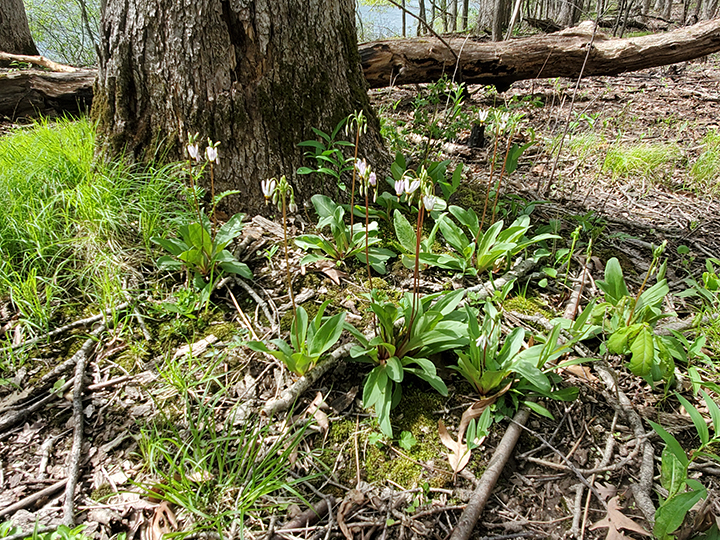
Wildflowers will thrive in the restored oak savanna
What’s Healthy for an Oak?
When you walk among the trees at Silverwood, look at the shape and characteristics of the oaks. You might notice some broken limbs and other signs of stress. They don’t have the full “dancing” shape that open-grown oaks have. That’s because in the woods, a lot of the lower limbs have been shaded out by competing trees. “In oak openings, the trees don’t have any competition,” Lars observed. “On the savannas they will grow horizontally to get the light they need, not just vertically. That’s where you see oaks with that awesome branch structure.”
Open-grown bur oaks can grow to great size. Bur and white oaks can be 500 or 600 years old; the average is in the 200 to 300 year range. The “Mother Oak”by the farmhouse is an example of an open-grown bur oak, estimated to be over 300 years old.
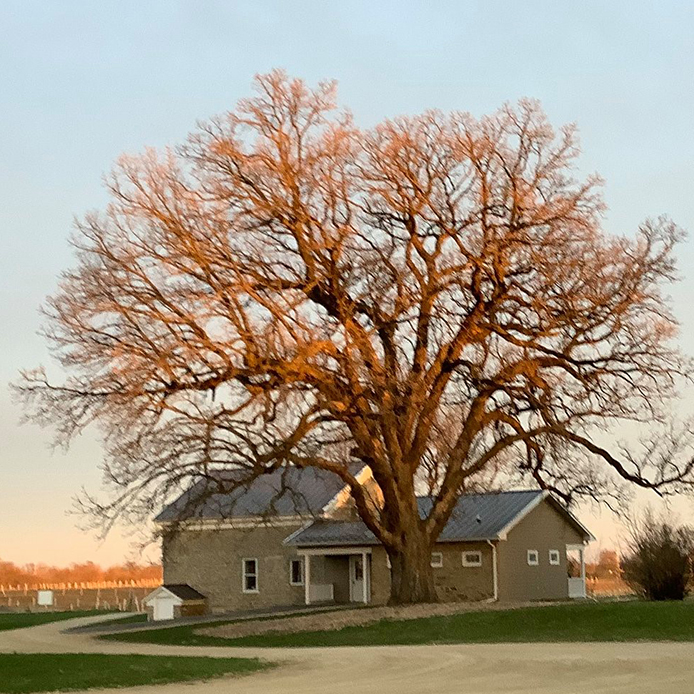
The “Mother Oak”by the Stonehouse Visitors Center is an example of an open-grown oak
Woods Work is Never Done
In past centuries, occasional fires helped shape the landscape here. Native Americans are known to have used burns to maintain oak savannas, so they probably burned this area regularly. Healthy oak trees create bountiful crops of acorns, a favorite food of turkeys, deer, and other animals, which makes the savanna ideal hunting grounds.
After the land became a farm, grazing cattle may have helped keep the landscape open. However, over the last 50 years, invasives have proliferated. “They have shaded out those lower limbs; oaks need a lot of light. They don’t tolerate deep shade very well,” said Lars. “The goal is not to turn the clock back two hundred years. We’re just trying to restore natural communities, especially ones that have been so damaged and destroyed that there are few examples left.” Plant, animal, and bird species now in decline need these specific habitats in order to flourish again.
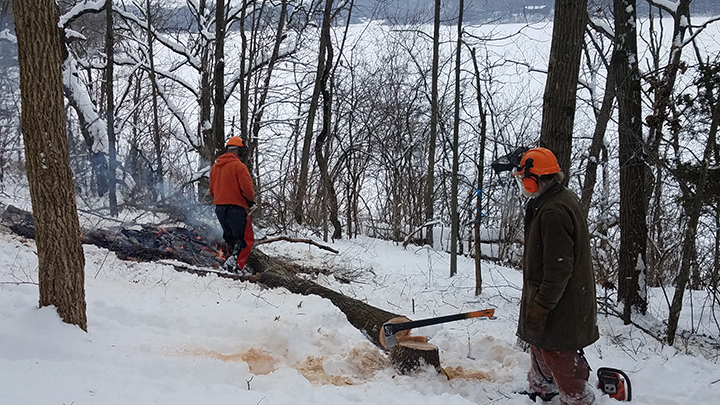
Regular burns will maintain Silverwood Park’s oak savanna as a healthy habitat
>Working with Lars Higden on the oak savanna/opening restoration is Rita Fox, Volunteer Woods Restoration Manager with Friends of Silverwood Park. “The next step is getting a logger in there to remove the bigger non-oak trees,” she said. While people tend to think that planting trees equals doing something positive, Lars said, “In these situations, cutting trees and removing invasive species is a good thing for the Earth.”
It has been surprisingly difficult to arrange for tree removal at Silverwood Park, since there is not a lot of demand for logging services in the mainly agricultural areas of southern Wisconsin. Once tree removal is complete, seeding with prairie plants and forbs and doing occasional controlled burns will help maintain the oak savanna, in keeping to the vegetation master plan.
Volunteers will always be needed to keep the area free of invasive plants, so we keep the woodland and prairie communities of Silverwood Park in good condition to educate about our southern Wisconsin landscape.
By Sarah White

